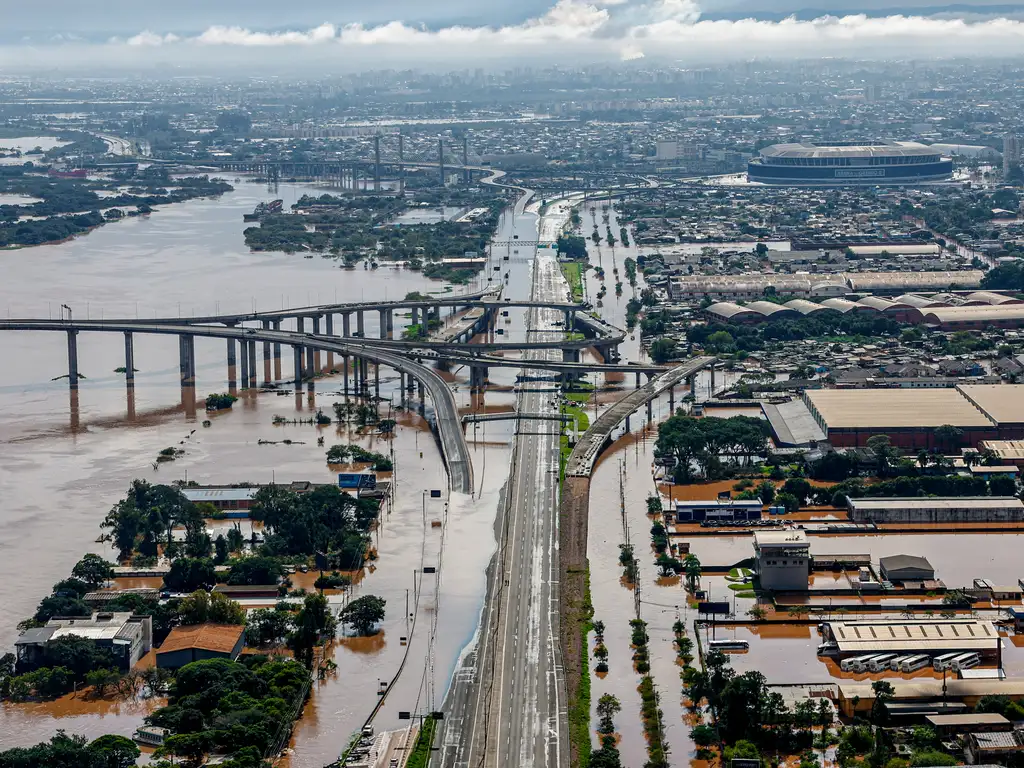São Paulo, Brazil – Heavy rains are devastating Rio Grande do Sul, the southernmost state of Brazil, on the border with Argentina and Uruguay, and have already left 75 people dead, more than 88,000 homeless and entire cities under water until this Sunday. There are at least 103 people missing and 155 injured due to the floods.
In total, 334 of the 496 cities in Rio Grande do Sul recorded some type of problem resulting from the rains, affecting 731,000 people, including the capital Porto Alegre, one of the largest cities in the country. In Porto Alegre, the main river, the Guaíba, exceeded five meters for the first time in its life, overflowing countless streets in the capital.
In its worst flood ever, Porto Alegre’s bus station and airport were under water and had to close, preventing many people from leaving the city for safer locations. Architect Bruna Corrêa is from Rio Grande do Sul, but has lived in São Paulo for five years. She was visiting her family in Porto Alegre when the heavy rains began on April 29.
She is trying to return to São Paulo, but cannot, as the airport is closed. “I left home at 3pm this Friday and my flight was at 8:25pm, but when I arrived, the airport was already closed indefinitely. Everything is flooded around the airport, there are many streets closed and you can’t get through because of the water,” she told Brazil Reports.
Corrêa returned to her sister’s house and doesn’t know when she will be able to leave Porto Alegre. “We are well and in a safe place, but you have no idea how sad it is here.” Just like Bruna, there are thousands of people facing difficulties in Rio Grande do Sul since the start of the rains, who continued to fall until this Sunday.
The state government declared a state of public calamity, recognized by the federal government, which facilitates Rio Grande do Sul’s access to federal resources to assist victims and rebuild cities. The federal government sent the Army and the National Security Force to help rescue stranded people.
Other Brazilian states and even the government of Uruguay also sent teams to help with the rescue, including helicopters and boats. Scenes of residents taken from rooftops by helicopters, with water covering their entire homes, became common this week.
The Brazilian Army is helping to rescue flood victims. Image courtesy of Ricardo Stuckert/PR
Governor Eduardo Leite referred to the tragedy as “the biggest climate disaster” in the history of Rio Grande do Sul. President Luiz Inácio Lula da Silva visited the state on Thursday and went back on Sunday, this time with the Presidents of the House and the Senate. Lula promised unlimited resources from the federal government.
“At first, we just have to save lives, we just have to take care of people. Then, we will have to take care of carrying out an assessment of the damage and, from there, start thinking about how to find the money so that we can repair this damage,” said Lula.
In addition to the dead and homeless, there are more than 400,000 people without electricity and more than 800,000 without water. Also, 180 highways are blocked, dozens of hills have collapsed and a dam is at risk of collapsing too.
Why is it raining so much in Rio Grande do Sul?
Meteorologists explain that the rains are the result of a series of factors: a heat wave in the central region of Brazil with high atmospheric pressure led to the formation of dry and hot air, which blocks the passage of cold fronts to the north of the country, according to meteorologist Marcelo Seluchi.
“These cold fronts come from Argentina, they quickly arrive in the south of Brazil and are unable to advance. We have a succession of cold fronts that have become stationary and are maintaining the rain for several days in the state,” Seluchi told Agência Brasil.
He does not rule out that the rains are a reflection of El Niño and climate change, as the atmosphere and oceans are warmer, producing additional steam to form rain.
Second tragedy in less than a year
Rio Grande do Sul has suffered from constant heavy rains in recent years. In September 2023, floods caused by an extratropical cyclone overflowed the Taquari River, in one of the worst floods in decades, and left a trail of destruction, material losses and 54 deaths.
“It’s the second event in a year, so we need to worry about taking care of the planet with much more care, with much more love,” said Lula. “Nature is manifesting itself and we need to take this into account, because when nature rebels we know that the damage will be big.”
Governor Eduardo Leite said that the rains of the last few days are worse than those of 2023: “The devastation we are being subjected to is unprecedented.” According to Leite, the state will need a kind of “Marshall Plan” to be rebuilt.
The post Rains in southern Brazil leave 75 dead, 88,000 homeless and entire cities under water appeared first on Brazil Reports.
The post Rains in southern Brazil leave 75 dead, 88,000 homeless and entire cities under water appeared first on Latin America Reports.



